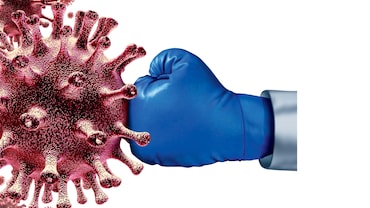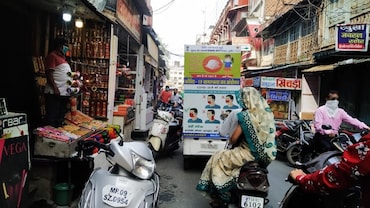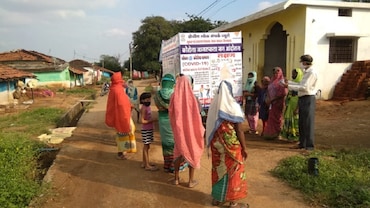- HOME
- /
- Coronavirus
- /
What Is Community Transmission, Is Herd Immunity An Effective Strategy-Everything You Wanted To Know About The Spread Of COVID-19
Two top doctors break down all things complex on COVID-19. From understanding community transmission and if India has reached that stage, to the right testing strategy for the country now
 Representational photo: Pixabay
Representational photo: Pixabay
What is community transmission?
Simply put, community transmission is the phase when an infection spreads to such an extent that it is impossible to trace its source in a patient. In the case of COVID-19 or coronavirus disease, which is caused by the severe acute respiratory syndrome coronavirus 2 or SARS-CoV-2, this is the time when you find that even people with no travel or contact history test positive for the infection.
For a pandemic like coronavirus, there are four stages of transmission. First, when the infection travels outside the country of origin—you can trace it to people with travel history to an affected area. Second, local transmission, when a cluster of cases is traced to a particular area. Containment measures and contact tracing can check the spread of the infection at this stage. The third stage is community transmission. The fourth stage is when the disease becomes endemic (or never goes away) in some countries.
Has India reached the community transmission stage for coronavirus disease?
No. “There is no such thing as an Indian epidemic. There is a Delhi epidemic, a Mumbai epidemic, an Indore epidemic etc. They’ll all peak at different times,” says Dr Ambarish Satwik, a vascular and endovascular surgeon at Sir Ganga Ram Hospital in Delhi.
But, in big cities like Delhi and Mumbai, there appears to be evidence of community transmission. “I am basing it on my experience of dealing with patients who can’t trace it to a particular contact,” says Dr Satwik, adding that “not saying it (community transmission) doesn’t change the reality on the ground”.
“We are dealing with a virus that spreads very fast,” says Professor K. Srinath Reddy, President, Public Health Foundation of India (PHFI) and Adjunct Professor of Epidemiology at Harvard.
“It can spread from people who are known to be infected but also from people who may be in their pre-symptomatic phase. Even some asymptomatic people may be harbouring an active virus. As such, we should take all precautions not to get infected as well as not infect others if we ourselves are in a pre-symptomatic phase and do not know it,” says Professor Reddy.
That’s essentially why we should continue to follow physical distancing, wear masks and practise hand hygiene to protect ourselves as well as others. “Behave as if every other person is infected and go about your daily life,” says Dr Satwik.
Is test, test, test, the only way to contain the spread of the virus at a community transmission stage?
At a media briefing on 16 March, World Health Organization (WHO) Director-General Tedros Adhanom Ghebreyesus said, “We have a simple message for all countries: test, test, test.”
While a case for ramping up testing facilities should definitely be made, experts say don’t test anybody in a haphazard manner without a level of prior-probability.
Testing is done essentially to identify a person who has the virus and isolate them as long as the virus is likely to be actively transmitted by that person to infect others.
“In terms of identifying the person, there has to be some criteria for performing the tests,” says Professor Reddy. “Those criteria can be extended and revised over time but they generally include any person who has symptoms suggestive of COVID-19 or the broader band of influenza-like symptoms because COVID-19 symptoms to some extent overlap with influenza,” he says. It also includes people who have a higher chance of carrying the virus because of their history of travel from a high virus-afflicted zone as well as those who are at a higher risk of viral exposure because of their occupation or proximity to virus-afflicted person.
“This is the group that qualifies very well for testing. This is what defines in a test prior-probability,” says Professor Reddy.
 Physical distancing, wearing masks and practising hand hygiene are a must to fight COVID-19. (Photo: Flickr)
Physical distancing, wearing masks and practising hand hygiene are a must to fight COVID-19. (Photo: Flickr)
What kind of testing strategy does India need right now?
The Indian Council of Medical Research’s (ICMR) testing strategy is fine, but it needs to be expanded a bit, says Dr Satwik.
While the ICMR guidelines currently allow symptomatic people with influenza-like illness (ILI) in hotspots and containment zones to get tested, Dr Satwik says this criterion should be expanded to include those with ILI symptoms in non-containment zones too. “Pre-admission testing of patients in hospitals should be allowed as well,” he says, because then a hospital can decide whether to keep the patient in a COVID or a non-COVID area.
As unlocking of the economy begins and more people go out, testing becomes more important so that the infected person is isolated as quickly as possible. “But even then, you have to use your testing strategically,” says Professor Reddy.
He adds that there is “absolutely no correlation between number of tests per million and number of deaths per million” and cites the example of Vietnam, a country that conducted relatively fewer tests but recorded zero deaths.
Testing is only one instrument of containment, say experts and stress on the importance of following other public health measures. “Testing needs to be followed by contact tracing, if you test and isolate only the infected person and don’t do contact tracing, you are still not preventing enough number of new infections,” says Professor Reddy.
Is herd immunity a solution to the COVID-19 crisis? Are the big affected cities reaching that stage?
Even big cities like Delhi and Mumbai, which have reported a high number of COVID-19 cases, are nowhere close to attaining herd immunity, say experts.
Professor Gypsyamber D’Souza and Associate Professor David W. Dowdy at Johns Hopkins Bloomberg School of Public Health define herd immunity as the stage “when most of a population is immune to an infectious disease, this provides indirect protection—or herd immunity (also called herd protection)—to those who are not immune to the disease”.
Herd immunity can be achieved either by a protective vaccine or when a certain number of people in a population get infected with the virus and develop immunity against it.
For most viruses, says Professor Reddy, the herd immunity threshold is nearly 60 per cent—in other words, 60 per cent of the population needs to get infected by the virus. “For this virus (SARS-CoV-2), which has such high infectivity rate, the herd immunity threshold is 80 per cent. Even in the containment zones, we are far from it,” he says.
In a country as big as India, achieving herd immunity all at once is next to impossible.
“Say 60-70 per cent people in Delhi get infected and claim herd immunity, what happens when someone from Delhi travels to a Raipur or a Ranchi where the virus has affected only 5-10 per cent people? If you happen to be one among the infected, you are safe, but if you are among the remaining 30-40 per cent population that did not have the infection because the virus stopped circulating in Delhi, you are still susceptible when you travel outside Delhi. You are no longer carrying your so-called immunity passport,” explains Professor Reddy.
D’Souza and Dowdy argue against adopting a herd immunity strategy. “For less severe diseases, this approach might be reasonable. But the situation for SARS-CoV-2 is very different: COVID-19 carries a much higher risk of severe disease and even death,” they say.
“It is a cop out,” says Professor Reddy.






